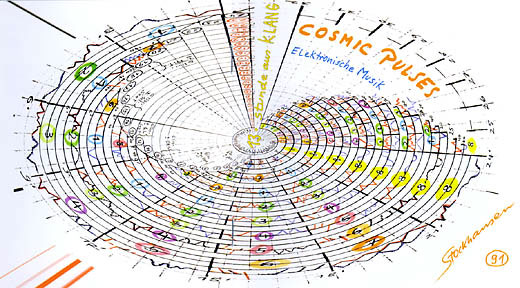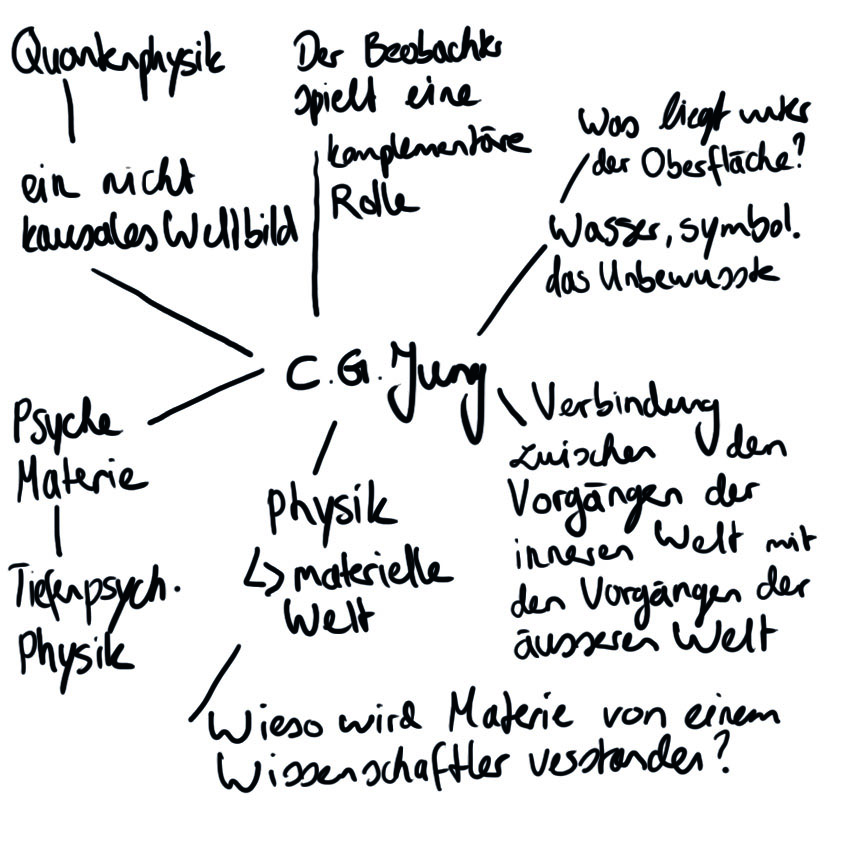kosmos_miryam
aus dem Werkzyklus Klang – die 24 Stunden des Tages von K.H. Stockhausen (zwischen 2004 und 2007)
13. Stunde – Cosmic Pulses
Der 2006 entstandene 13. Teil des Zyklus Cosmic Pulses ist reine elektronische Musik, die über acht Lautsprecherpaare übertragen wird und aus 24 melodischen Schleifen besteht. Diese wiederum sind in verschiedenen Tonhöhen von 1 bis 24 notiert. Die melodischen Schleifen laufen in 24 unterschiedlichen Tempi und 24 Registern ab, die etwa sieben Oktaven umfassen.
Karlheinz Stockhausen erklärte die Schleifen und Schichtungen folgendermaßen:
„Die Schleifen werden nacheinander von der Tiefe zur Höhe und vom langsamsten bis zum schnellsten Tempo übereinandergeschichtet und setzen danach in dieser Reihenfolge nacheinander aus. … Das für mich vollkommen Neue ist die neue Art von Verräumlichung: Jeder Abschnitt einer der 24 Schichten hat seine eigene Raumbewegung zwischen acht Lautsprechern, so dass ich 241 verschiedene Raumbahnen zu komponieren hatte. … Ich habe zum ersten Male eine Überlagerung von 24 Klangschichten ausprobiert, als hätte ich die Rotationen von 24 Monden oder 24 Planeten zu komponieren. […] Ob man alles hören kann, weiß ich noch nicht; es hängt davon ab, wie oft man eine 8-kanalige Aufführung erlebt.“[21]
An anderer Stelle verglich Stockhausen diese Komposition, die er als eine Art „Sternensystem“ verstand, mit der Aufgabe „24 Planeten um eine Sonne mit individuellen Rotationen, Tempi und Flugbahnen zu synchronisieren.“
Quelle: https://de.wikipedia.org/wiki/Klang_(Stockhausen)
zum Reinhören: cosmic pulses, Karlheinz Stockhausen
IS THERE ANY WORLD TO COME?, Déborah Danowski & Eduardo Viveiros de Castro {Melanie}
(…)
At first, then, everything was originally human, or rather, nothing was not human (except for tortoises, of course, according to the Aikewara). A considerable number of Amerindian myths—as well as some from other ethnographic regions—imagine the existence of a primordial humankind, whether fabricated by a demiurge or simply presupposed as the only substance or matter out of which the world could have come to be formed.
These are narratives about a time before the beginning of time, an era or eon that we could call “pre-cosmological.”4 These primordial people were not fully human in the sense that we are, since, despite having the same mental faculties as us, they possessed great anatomic plasticity and a certain penchant for immoral conduct (incest, cannibalism). After a series of exploits, some groups of this primordial humankind progressively morphed—either spontaneously or due to the action of a demiurge—into the biological species, geographical features, meteorological phenomena, and celestial bodies that comprise the present cosmos. The part that did not change is the historical, or contemporary, humankind.
(…)
What we call the environment is for them a society of societies, an international arena, a cosmopoliteia. There is, therefore, no absolute difference in status between society and environment, as if the first were the subject and the second the object. Every object is always another subject, and is always more than one.
(…)
‘COSMOS AS COMMONS: An Activation of Cosmic Diplomacy’, Debora Battaglia {Melanie}
(…) Here, I stress the critical point of cosmic
diplomacy, on one level, for adding into the mix of
voices and doings of spirits and humans, some of
nature’s own; on another, for asking what the
poetics of “shamanism in action” might be
offering science in action, in the service of a
cosmopolitical consciousness (as Stengers
conceives of this), and vice versa. This “dance” of
translatability opens to recognizing for the myth
it is any possible “escape from perspective”
which, as Goetz Hoeppe takes up the point from
his theoretical ethnography of astronomical
practice, has historically “been conceived as a
pathway to objectivity” by scientists.12 Further, it
appreciates that “observing and theorizing are
perspectival not just in a geometrical-optical
sense, but more generally so in terms of the
diverse properties of the instruments, models,
and theories which scientists use and the aims
they use them for” [emphasis mine] – a point of
Giere’s which Hoeppe echoes in his study of
astronomers, who work in effect collaboratively
from widely separated field sites.13 The point
bears extending to the aims of shamans,
ethnographers, and the objects of their study. By
placing reflexivity at the armature of
accountability for what Hoeppe terms the “tacit
cosmologies” of experienced scientists who
routinely subject their data sets to diverse
“evidential contexts” and to their own
professional histories as a kind of “sanity check,”
we find ourselves positioned to examine
moments when specialist knowledge and aims in
different locations warm to each other by the
invitation of not-quite or not-yet perceivable, but
(as themselves only) inherently trustworthy,
natural phenomena – a practical expression of
what Eduardo Viveiros de Castro terms
“multinatural formations”.
Consider further these scenarios of
diplomatic first contact. (..)
Debbora Battaglia is Five College Fortieth Anniversary Professor of Anthropology at Mount Holyoke College. Ongoing interests include personhood, alienness and belonging; the cosmopolitics and socioaesthetics of world-making; visual anthropology in the material world; the anthropology of science and technology
Kosmos_Laura
Notizen:
Die Psyche ist eine Eigenschaft, die in der Materie (Körper) auftaucht.
Klassische Physik: alles ist genau berechenbar
Die Natur ist nicht mit einem eindeutigen Gesetz zu erklären, welches alle Naturereignisse beschreibt -> Suche nach der Einheit unter allen Erscheinungen.
Quantenphysik: nicht genau berechenbar
Die Quantentheorie kann dennoch nicht vollständig sein, da sie die Rolle des Unbewussten nicht miteinbezieht?
Psyche und Materie existieren in derselben Welt und beeinflussen einander -> zwischen der Physik und der Psychologie besteht eine komplementäre Beziehung, so müsste man zu gemeinsam Begriffen der Physik und der Psychologie gelangen.
Der Beobachter (Mensch) spielt eine Rolle, er verändert die Situation.
Wenn sich Psyche und Materie in derselben Welt befinden, so sind sie vermutlich Aspekte derselben Sache.









